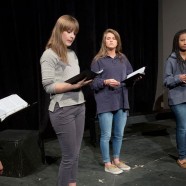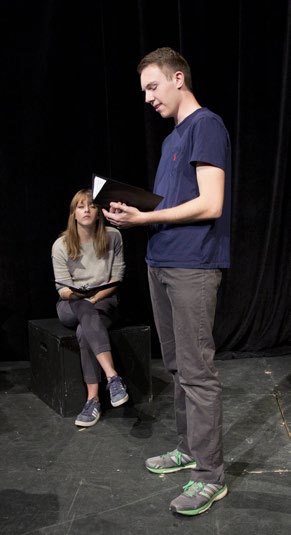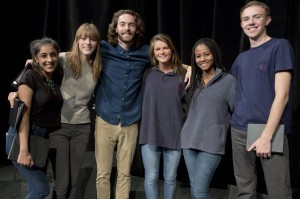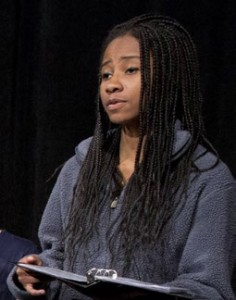
In the black box, six students shift quietly about the stage, taking positions to give public voice to the raw, or eloquent, or plaintive comments that emerged during more than 30 interviews. The actors, in their dark or neutral street-wear, recede physically, which isolates and emphasizes their words slicing through the air, riveting the audience. The script, which they sculpted from their transcribed interviews, sketches vulnerability in different shapes and sizes. It uses their narrators’ exact phrases. “Narrators” are those people who answered student questions with startling honesty, gave them personal stories. In total, the narrators show “real safety” as pretty elusive — compromised at best, and often out of reach.
Several months ago these six juniors and seniors set out to probe the ambiguous terrain of emotional and physical safety. Bringing to the stage what they found culminates one second-semester project for the course Narrative Journalism and Performance. It’s “hands on”; they learn narrative journalism skills, performance skills and peer workshopping, through practice. With their co-teachers, Lisa Baker (English) and Peter Parisi (chair, Performing Arts), they identify, research, write and perform stories from within and beyond Milton Academy.
 This particular storytelling project was to be a collaborative venture. “We filled an entire whiteboard with brainstorming ideas,” Chloe LeStage ’17 remembers, “materialism, race, religion, the meaning of love, helicopter parents, lockdowns, depression, the meaning of art, and how adolescence has changed.” Their previous projects had already taught them how listening well, standing in another’s shoes and telling his story, can completely alter your awareness, and create newfound empathy. In this round, they wanted to trigger a new level of discovery by asking questions that held a mirror up to the Milton community itself. Peter Parisi recalls that during an intense conversation in the dorm one night, after a Republican presidential candidates’ debate, Norris boys turned to him and asked, “Well, what are you willing to compromise, Mr. Parisi, your safety or your freedom?” In class after that encounter, he and others began to see that feelings about safety were hard-wired to many of the ideas the class wanted to test. What does safety mean to you, and how much or how little safety do you feel? “We wanted to offer conflicting perspectives and experiences,” says Kellie Quinn ’16, “because it’s clear that people’s backgrounds and roles lead to different senses of what safety means for them.”
This particular storytelling project was to be a collaborative venture. “We filled an entire whiteboard with brainstorming ideas,” Chloe LeStage ’17 remembers, “materialism, race, religion, the meaning of love, helicopter parents, lockdowns, depression, the meaning of art, and how adolescence has changed.” Their previous projects had already taught them how listening well, standing in another’s shoes and telling his story, can completely alter your awareness, and create newfound empathy. In this round, they wanted to trigger a new level of discovery by asking questions that held a mirror up to the Milton community itself. Peter Parisi recalls that during an intense conversation in the dorm one night, after a Republican presidential candidates’ debate, Norris boys turned to him and asked, “Well, what are you willing to compromise, Mr. Parisi, your safety or your freedom?” In class after that encounter, he and others began to see that feelings about safety were hard-wired to many of the ideas the class wanted to test. What does safety mean to you, and how much or how little safety do you feel? “We wanted to offer conflicting perspectives and experiences,” says Kellie Quinn ’16, “because it’s clear that people’s backgrounds and roles lead to different senses of what safety means for them.”
Slicing the topic into three areas (physical safety, emotional safety and “post 9/11 parenting”) researched by three, two-student teams, they named their target narrators, and set about interviewing: teachers and counselors, campus safety officers and administrators, fellow students and parents.
Adam Bramson ’16 led the questioning at a panel discussion with Upper School parents; Chloe and Henry Westerman ’17 led the mirror panel with Middle and Lower School parents. “I know from my own mom how much things have changed since she was a child,” Adam says, “when she basically did her chores and went outside and played all over the neighborhood with her friends.” He found parents chilled by violent events; both empowered and flummoxed by the internet; avidly seeking a “balance” between programming their kids, striving for their achievement, and trying to make sure they are happy. They each confided having taken a certain course of action, but not feeling the least bit confident that they might be on the right track. “So immediately in your mind, the world is a really scary place that you need to protect your children from, as opposed to the world is an amazing place that you want your child to explore and be a part of,” says one parent. A school counselor’s approach may make good sense: “I think it is important to learn to fail, to learn to hear things that are uncomfortable, to know that the world isn’t a safe place, and inherently by doing that, you’re building your resilience.” But as another narrator said, “It’s hard to be a mellow parent.”
Musing, Adam says, “Parents seem to want to teach their own kids now, based on what happened to them, even though things about adolescence have changed.” Henry can’t help but note the conflict parents are feeling: being against over-scheduling and over-protecting, and yet doing exactly that. “Seeing them changed how I think,” says Henry, “hearing what and how parents think. It’s important that we acknowledge what’s real for them.”
 “Understanding how much adults on campus have to worry about was eye-opening,” says Kellie. “Like Mr. Ball (Upper School principal) when he’s the administrator on duty for the dorms. While he’s on duty, he thinks continually of what range of things might happen, what he may need to do—and what the right thing to do will be.”
“Understanding how much adults on campus have to worry about was eye-opening,” says Kellie. “Like Mr. Ball (Upper School principal) when he’s the administrator on duty for the dorms. While he’s on duty, he thinks continually of what range of things might happen, what he may need to do—and what the right thing to do will be.”
David Ball told Kellie that the Boston Marathon bombing stood out as a distinctive challenge in his memory. In the script, another administrator recalls that day: “I got a call from the boarding monitor. I had no idea what had happened, and the first thing he said was, ‘We’re all okay, the bombs went off really close to us by the finish line.’ And I said, ‘What are you talking about?’ I remember that moment and then kind of going through the whole process of: ‘All right, so here’s what I need you to do. Give me a good sense of where you are,’ stuff like that, and walking this kid through getting out of the city and back to campus or to places we could actually get to them. That was what we were thinking. There was no … confidence that if you sent them this place or that place that you were going to be sending them away from danger.”
One narrator, an adult pointing to the terror attacks in Paris and Brussels, says, “I don’t think gathering places are safe anymore. … There are people out there who want to cause harm.” The same person says, convincingly, “We don’t hear about the times that guns actually protect someone, where lives have been saved because someone has been carrying a gun. We don’t hear about that in the news—you don’t have the complete picture.”
Without attribution, the words in the script stand for themselves. As Henry says, “Our narrators didn’t need to be worried about being judged. So we can have a debate onstage that never could have happened offstage. People would be too afraid to say what they believe.”
Crafting the script, students learn that some of its power springs from juxtaposition. Following one deeply held point of view with a counterpoint marks up a reality we rarely consider—as when this student narrator enters the flow: “When you come from a community where a lot of kids don’t live to see the next day, of course you’re going to tell that kid: ‘Well maybe don’t wear that hoodie’ or ‘Don’t stand on that corner.’ Black kids have to grow up faster. As a kid, I was told, ‘Hey, the police are gonna give you a tougher time. You’re going to be seen as more aggressive no matter what you do or say, so here’s what you need to do: When you get pulled over, keep your hands on the wheel. Don’t make eye contact. Only answer questions when spoken to. And whatever you do, do not make sudden movements.’ I think I had that conversation when I was seven.”
 Or from a parent anticipating that very encounter: “We have a black son, so whenever I see a kid, or a black person getting arrested, we sit and watch and talk about what that person did right while getting arrested. ‘If a cop comes up to you, take your hands out of your pockets and spread your fingers.’ When we drive by someone who’s pulled over in Milton, my son always looks and says, ‘Oh look, another black guy pulled over.’ I told him the other day that he’s not allowed to cut through backyards. He’s gotta stay on the street because people get nervous when they see kids, black kids, cutting through their backyard.”
Or from a parent anticipating that very encounter: “We have a black son, so whenever I see a kid, or a black person getting arrested, we sit and watch and talk about what that person did right while getting arrested. ‘If a cop comes up to you, take your hands out of your pockets and spread your fingers.’ When we drive by someone who’s pulled over in Milton, my son always looks and says, ‘Oh look, another black guy pulled over.’ I told him the other day that he’s not allowed to cut through backyards. He’s gotta stay on the street because people get nervous when they see kids, black kids, cutting through their backyard.”
“None of this is fiction,” says Eshani Chakrabarti ’17, reflecting on her classmates’ challenge, sifting through pages and pages of transcribed interviews to create a script that respects all the voices. “It shows how important understanding real experiences and being open with one another are. The majority opinion is not the only opinion. Some of our best days were spent arguing about what needed to be included in the script.”
Eshani’s interviews explored language as a vector. “How would you define political correctness?” she would begin, becoming increasingly aware of what a complicated, simple question she was asking. “I didn’t know where I stood,” she says.
“People are not things,” one narrator says. “They are not statistics. They are not game pieces. They are precious beings and we should treat one another the way we’d have others treat us. Which means not to be dismissed, not to be referred to by a slur, not to be defined as an object or a purpose for someone else. I tend not to use that term, political correctness, because it sounds like a kind of autocratic or totalitarian term or something out of 1984 … that term is in itself kind of a minefield of ordering people how to speak, when the point of it is to be mindful and to listen to other people.”
What does “teaching” mean when those inevitable comments spill out, when young people of vastly different backgrounds—naïve, myopic, probing young people—engage around a table? As a student narrator said, “It’s not so much physical safety, but emotional and mental safety I am concerned about, just because the community is largely ignorant. Everything from micro-aggressions to well-intentioned kids saying the wrong thing and then not caring that they did—all of that has a compounding effect on your ability to focus on things, like school or sports or doing what you have to do. It’s a distraction.”
A teacher re-created an encounter of decades ago, when boys in his class were trading “faggot” comments all around. He was aware then that one boy in the room may have been gay. In his retelling, the teacher turned similarly degrading comments on each of the boys, explicit to their race or ethnicity. They were furious. “And I said, ‘You see? What did I just do?’ And they got it. They got it. They were talking in a way that was so offensive to anyone who might—it was offensive to me! I didn’t say, ‘You boys, now’ [wagging finger], I wasn’t going to give them a lecture. It was visceral. And that’s what I think we’re lacking now, a visceral response. I don’t think anyone today would do what I did then.”
His story connects with another narrator’s insight: “I have a lot of empathy for people who have to walk into rooms and size up if they’re safe. Is there anyone who looks like me here? Is there anyone who seems like I might be able to trust them? Do I have to worry about having to represent everybody who looks like me? It’s a huge burden, and if you carry it all the time, you take it in stride, but it conditions your whole life.”
That “only person in the room” syndrome plays out in many ways: “If I’m in a group, and I’m the only student of color and someone makes a joke, it’s kind of like I have to decide whether or not to be offended and whether or not to state that offense, because the second I do, I’m bringing the conversation to a level that a lot of people don’t want to be on,” says a student. “It makes me feel very uncomfortable, because people might be like, oh, she had to bring it back to race, she always does, but it’s like I don’t have the privilege of not saying something in that situation. I guess that makes me feel unsafe.”
Perhaps the identity issue is captured most succinctly by another student narrator: “As far as unsafe goes, I feel like when you are required to prove something to someone, that is really nerve-racking.”
Now in their third year of teaching the course, Lisa Baker and Peter Parisi have learned that they can be two “experts” in the room, working together, agreeing, disagreeing, in real time, collaborating with students to reach high standards of reporting, crafting stories, performing publicly.
“Ms. Baker brought a focus on how to tell a story,” Chloe says, “how to get a message across: what to emphasize, what to withhold, how it moved.
“Both teachers were active on every issue over the whole course, with good and congruent opinions and differences in opinions. The class was really collaborative. I loved the interviewing the best,” she adds. “I was able to go deeply into a subject with someone I didn’t know.”
“I didn’t expect to get such valuable words,” Cheyenne Porcher ’17 says. “Each person was so candid. Then we had to see how to fit it all together. During the interview, we can’t interrupt and disagree. It’s so different from a conversation where people listen just to respond rather than to understand. Then afterward, I couldn’t take something out just because I disagreed with it.
“As performers, we’re all embodying many personas, making sure we get the language right,” says Cheyenne.
“Every person is represented [in performance] in the most important way,” says Adam. “We each played several narrators; we were performing as people I don’t know, or didn’t hear, and wasn’t there, and we had to give each narrator his own respect.”
“We tell the kids to own the language,” says Peter. “We are gifted with honesty. What is the emotional content? We need to feel and express the emotion.”
“Our goal, really, was to encourage listeners, to encourage people to be more thoughtful,” Adam says. “From Ms. Baker and Mr. Parisi I learned that it is amazing what you can learn from the art of listening,” says Henry. “This is a cool art form, storytelling.”
“This story says so much about Milton,” says Chloe. “There are so many different perspectives. Milton is speaking, but it’s about the world.
“It will be revealing, what sort of impact this kind of storytelling can have.”
by Cathleen Everett



